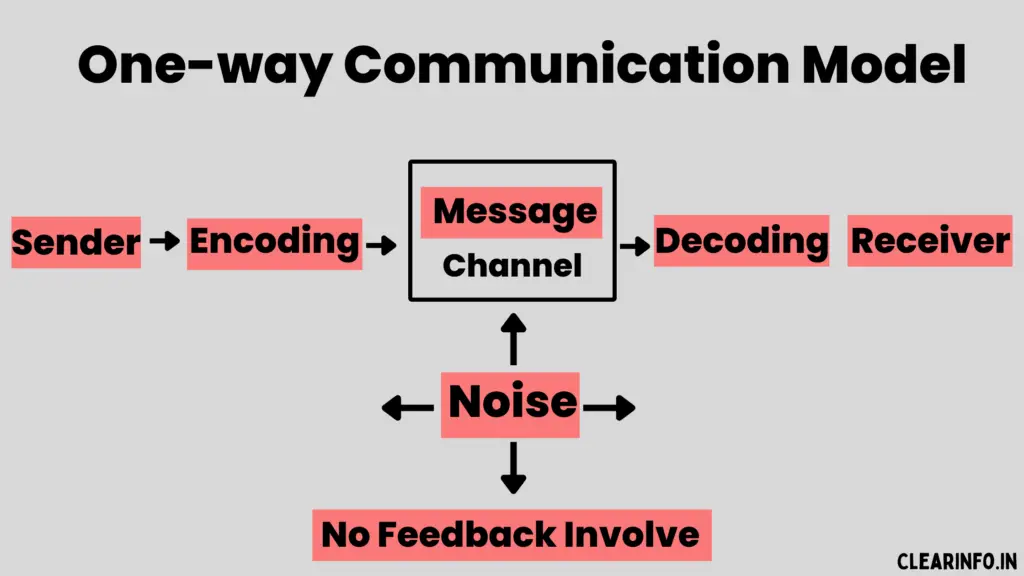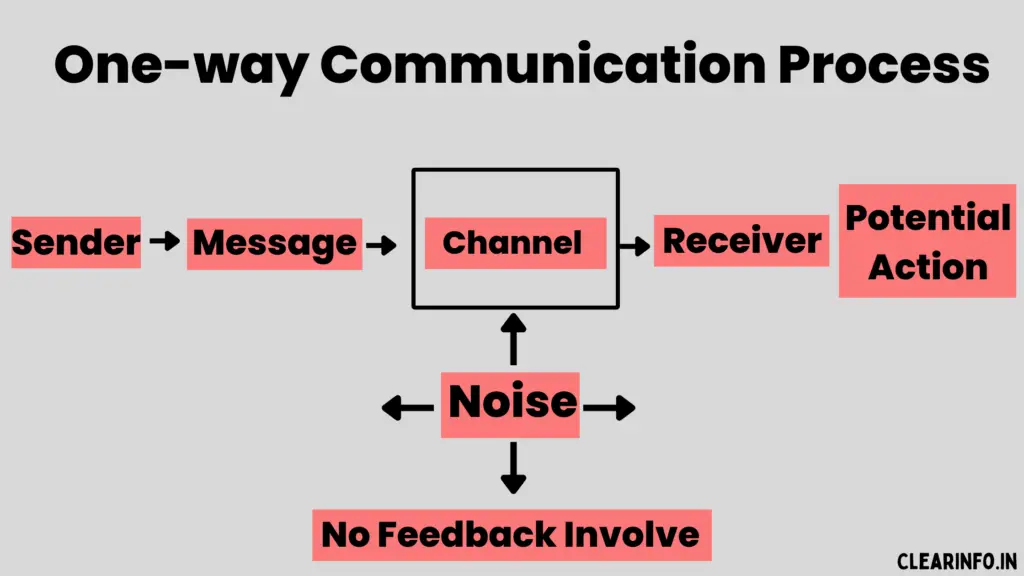In the realm of communication, interactions between individuals take various forms. One such form is one-way communication, a one-sided exchange of information that flows from a sender to a receiver without feedback.
While two-way communication involving active dialogue is often emphasized as ideal, understanding the dynamics and significance of one-way communication is equally important.
In this blog, we will delve into the detail of one-way communication, exploring its definition, characteristics, examples, advantages, limitations, and the role of technology in shaping this mode of communication.
Definition of One-way communication
One-way communication is a linear process in which the sender controls the message and the receiver’s role is primarily passive.
In “Communication: Principles for a Lifetime,” Steven A. Beebe and Susan J. Beebe describe
What is one-way communication?
One-way communication is a type of communication where information is transmitted from a sender to a receiver without any feedback or response from the receiver. In this type of communication, the sender is the sole source of information, and the receiver acts as a passive recipient.
Unlike interactive forms of communication where there is a continuous exchange of ideas and feedback between participants, one-way communication does not involve any response or feedback from the receiver. The sender shares information or a message with the receiver, but there is no expectation of active engagement or dialogue.
In one-way communication, the sender holds the power to control the message and its delivery. The sender determines what information to share, how it is presented, and when it is shared. The receiver, on the other hand, has little to no influence over the message or the communication process.
It is important to note that one-way communication is often used in situations where the primary goal is to share information, provide instructions, or deliver messages to a large audience efficiently.
One-way communication model

3 main components of the one-way communication model
The three main components of the one-way communication model are:
- Sender: Initiates the communication process and encodes the message.
- Message: The content or information being communicated.
- Receiver: The intended audience who decodes and interprets the message.
These components work in a unidirectional flow from the sender to the receiver without immediate feedback.
Characteristics of one-way communication
One-way communication possesses several key characteristics that distinguish it from interactive forms of communication. Let’s delve into each feature in detail:
1/ Unidirectional nature: One-way communication is characterized by a unidirectional flow of information. It means that the communication process occurs in a single direction, from the sender to the receiver. The sender initiates the communication by conveying a message, while the receiver’s role is limited to receiving and understanding the message. There is no expectation of a back-and-forth exchange of information.
2/ Absence of feedback: One of the defining features of one-way communication is the lack of immediate response or feedback from the receiver. Unlike interactive forms of communication where feedback is exchanged continuously, one-way communication typically does not involve the receiver providing any form of feedback. The sender does not expect or anticipate a response from the receiver, making it a predominantly sender-driven communication process.
3/ Limited interaction: One-way communication involves limited interaction between the sender and the receiver. The sender retains control over the message, and the receiver’s role is primarily to listen, read, or observe the information being transmitted. The receiver does not actively participate in shaping or influencing the communication process. This limited interaction can restrict the depth of understanding, engagement, and collaborative problem-solving that can be achieved compared to two-way communication methods.
4/ Information dissemination: One-way communication is often employed as a means of efficiently disseminating information or delivering instructions. It is particularly useful when the sender’s primary objective is to convey information to a large audience or share important updates. Examples of situations where information dissemination is a key goal include public speeches, broadcasts, company-wide announcements, or advertising campaigns.
One-way communication examples
One-way communication is common in various real-world scenarios. While these forms of communication effectively reach a large audience and share information efficiently, they often lack the interactivity and engagement found in two-way communication. Here are some examples that illustrate the use of one-way communication:
1/ Public speeches: Political speeches, lectures, or keynote addresses are classic examples of one-way communication. The speaker delivers a prepared message to an audience, aiming to inform, persuade, or inspire them. The audience typically assumes a passive role by attentively receiving and absorbing the conveyed information, without actively participating in the communication process.
2/ Broadcasting: Television and radio programs provide another common example of one-way communication. Broadcasters deliver news or educational content to a passive audience. Viewers receive the information without the opportunity for immediate interaction with the broadcaster.
Example of one-way communication in the workplace
1/ Announcements: In organizational settings, one-way communication is often utilized for making announcements. This can include company-wide emails, newsletters, or press releases. The sender, such as a manager or a public relations team, shares important information, updates, or instructions with employees, and stakeholders. The recipients receive the information without necessarily providing direct feedback or engaging in a conversation.
2/ Advertising: Advertising campaigns heavily rely on one-way communication to promote products, services, or brands. Print ads, billboards, or television commercials are designed to convey a message to a wide audience. The objective is to raise awareness and influence potential consumers. Although viewers or readers may have limited ability to provide feedback, the primary purpose is to deliver the message effectively and influence consumer behavior.
One-way communication process
In the one-way communication process, information is transmitted from a sender to a receiver without a response from the receiver. Here is an overview of the one-way communication process:

1/ Sender: The sender is the initiator of the communication process. They have a message or information they want to convey to the receiver.
2/ Message: The message refers to the informational content that the sender intends to convey to the receiver. It can take various forms, such as spoken words, written text, visuals, or audiovisual presentations.
3/ Channel: The channel represents the method employed to transmit the message from the sender to the receiver. It can be a physical channel, such as face-to-face communication, written documents, or electronic channels, including email or social media.
4/ Receiver: The receiver is responsible for decoding the message, which involves interpreting and understanding the information provided by the sender. The receiver’s understanding may be influenced by their knowledge, experiences, and perception of the message, which can vary from person to person.
5/ Potential Action: Depending on the nature of the message and the desired outcome, the receiver may take action based on the information received. This action can vary from following instructions, making decisions, forming opinions, or adopting certain behaviors. However, the sender may not be aware of these actions unless there is a separate feedback mechanism or a subsequent communication process.
Expert Tip: It is important to note that there is an absence of immediate feedback. Unlike two-way communication where there is a back-and-forth exchange, in one-way communication, the sender does not receive an immediate response or reaction from the receiver.
Why is one-way communication important
One-way communication holds importance in various contexts due to its ability to efficiently convey information and messages to a wide audience. It serves as a valuable tool for delivering announcements or sharing instructions on a large scale. One-way communication enables senders to reach a broad group of individuals simultaneously, ensuring that important information is shared quickly and effectively.
Through one-sided communication the senders can control the content being communicated, ensuring consistency in the message conveyed. By leveraging one-way communication channels, individuals and organizations can achieve efficient communication, making it an essential component of effective communication strategies.
What is one-way communication in business?
One-way communication in business refers to a unidirectional flow of information where messages are transmitted from the organization to the target audience without expecting a response.
In business, one-way communication is often used for various purposes such as sharing company announcements, delivering instructions, or broadcasting promotional messages. It allows businesses to efficiently convey information to a large audience, maintain consistent messaging, and establish their authority in the communication process.
However, it is important to note that in business communication, a balanced approach that incorporates interactive and two-way communication methods is crucial for building meaningful relationships with stakeholders.
What are some strategies to overcome one-way communication in the workplace?
The following strategies aim to foster two-way communication and create an environment that promotes open dialogue and collaboration. Here are some effective approaches:
1/ Encourage feedback: Actively promote and encourage employees to provide feedback on various aspects of the organization, such as processes, policies, and initiatives. Foster a culture of open communication where feedback in business communication is valued and sought after. Create channels, such as suggestion boxes, surveys, or regular feedback sessions, to allow employees to share their thoughts and ideas openly.
2/ Utilize collaborative tools and platforms: Implement collaborative tools and platforms, such as project management software or business communication platform, that allow employees to share information, exchange ideas, and collaborate on projects in real-time. These tools facilitate communication, transparency, and teamwork.
3/ Provide training and workshops: Offer communication skills training and workshops to employees to enhance their ability to effectively express their thoughts and actively listen to others. Focus on skills like active listening, conflict resolution, and constructive feedback to promote meaningful interactions.
4/ Use town hall meetings or Q&A sessions: Organize town hall meetings or Q&A sessions where leaders address employee questions, concerns, and suggestions openly. This allows for direct communication between employees and leaders, promoting transparency and a sense of involvement.
What model of communication uses one-way communication
The one-way communication model is primarily associated with the linear or transmission model of communication. In the linear model, communication occurs in a one-way flow, where information moves exclusively from the sender to the receiver without any feedback. It follows a linear path where the sender encodes the message, which is then transmitted through a chosen channel to the receiver, who decodes and interprets the message.
In this model, the emphasis is on the transmission of information from the sender to the receiver, with little to no opportunity for the receiver to provide immediate feedback or engage in a dialogue. The sender has control over the message, and the receiver’s role is primarily passive, focused on understanding and interpreting the message.
The linear model is often associated with forms of mass communication, such as public speeches, broadcasting, announcements, or advertising. These forms of communication are designed to reach a large audience and spread information or messages efficiently, without the expectation of immediate response or interaction.
Advantages and disadvantages of one-way communication
Advantages of one-way communication
One-way communication offers several advantages in specific contexts. Let’s explore the benefits of using one-way communication:
1/ Efficient dissemination: One-way communication is particularly effective when there is a need to share information quickly and widely. In situations where a large audience needs to be reached simultaneously, such as during public speeches, broadcasts, or mass email announcements, one-way communication allows for the efficient distribution of information without the need for individual interaction. This makes it a valuable tool for rapidly conveying messages to a broad audience.
2/ Control over the message: One-way communication enables senders to maintain control over the content of the message. The sender has the ability to craft the message precisely, ensuring its accuracy and consistency. By controlling the message, senders can deliver information in a structured and focused manner, aligning it with their intended objectives, values, or brand image. This control helps maintain the integrity and clarity of the communication.
3/ Time-saving and cost-effective: One-way communication can save time, both for the sender and the receiver. The sender can efficiently transmit information without the need for immediate feedback or lengthy discussions. This is advantageous when time is a constraint or when delivering concise messages is crucial. Similarly, the receiver can absorb the information at their own pace without engaging in real-time dialogue, allowing them to process the message efficiently and move on to other activities.
Disadvantages of one-way communication
While one-way communication offers certain advantages, it also comes with significant drawbacks and limitations. Let’s explore the key limitations of relying solely on one-way communication:
1/ Lack of feedback: One of the primary limitations of one-way communication is the absence of immediate feedback from the receiver. Without feedback, the sender cannot know whether the message has been understood, accepted, or even received by the intended audience. The sender does not have the opportunity to assess the effectiveness of their communication and make any required adjustments or clarifications.
2/ Limited engagement: One-way communication restricts active participation and engagement from the receiver. As the sender maintains control over the communication process, the receiver’s role is reduced to that of a passive recipient. This limited engagement can prevent the development of a deeper understanding or the opportunity to explore different perspectives. The absence of interaction and dialogue can result in decreased interest and a lack of motivation to fully process the information.
3/ Lack of context and non-verbal cues: One-way communication often lacks the richness of context and non-verbal cues that are essential for effective communication. In face-to-face or interactive communication, non-verbal cues such as body language, facial expressions, and tone of voice play a significant role in conveying meaning and understanding. One-way communication, such as written messages or recorded videos, may not adequately capture these contextual and non-verbal elements, potentially leading to incomplete interpretation of the message.
Role of technology in one-way communication
Technology has significantly influenced the landscape of one-way communication, providing new avenues and platforms for reaching audiences. Here’s how technology has impacted one-way communication:
- Social media and online platforms: Platforms such as Twitter, YouTube, Instagram, and Facebook have become popular channels for one-way communication. Public figures, organizations, and influencers use these platforms to share information, opinions, announcements, or insights with a broad audience.
- Email and newsletters: Technology has revolutionized communication in business through email and digital newsletters. The advantages of email communication in business are evident as companies leverage these tools to efficiently share updates, news, and announcements with employees and customers. Email enables the quick distribution of information to recipients’ inboxes. While digital newsletters provide a format for delivering curated content and updates to subscribers, often in a visually appealing and interactive manner.
- Digital advertising: Technology has transformed the field of advertising, enabling one-way communication with targeted audiences. Online ads, pop-ups, sponsored content, and social media promotions are common forms of one-way communication for marketing purposes.
The role of technology in one-way communication has provided greater accessibility, reach, and efficiency. It has allowed individuals and organizations to disseminate information on a larger scale and target specific audiences with precision. However, it is essential to recognize that technology should be used strategically, and the limitations of one-way communication should be considered.
Balancing One-Way Communication with Two-Way Communication
In order to foster more effective communication outcomes, it is crucial to incorporate two-way communication methods. Here’s why balancing one-way communication with two-way communication is essential:
- Enhanced understanding: Two-way communication allows for a deeper understanding of ideas, perspectives, and concerns. By actively engaging in dialogue, individuals have the chance to inquire and obtain valuable insights from others.
- Collaboration and idea generation: Two-way communication facilitates collaboration and idea generation by encouraging the exchange of diverse viewpoints. Through interactive discussions, brainstorming sessions, or team meetings, individuals can contribute their unique perspectives, expertise, and experiences. This collaborative approach can lead to innovative solutions, improved decision-making, and a sense of ownership and involvement among participants.
- Engagement and relationship-building: Two-way communication fosters active engagement and participation from all parties involved. Whether it’s face-to-face conversations or interactive online platforms, these methods create an environment where individuals can express their thoughts, provide feedback, and feel heard.
Further Reading: What is Two-way Communication: Examples, Elements & Importance
Frequently Asked Questions
Q1) What is one-way communication and examples?
Ans: One-way communication refers to a form of communication where information flows from a sender to a receiver without any feedback or response. Examples of one-way communication include public speeches, announcements, and television commercials.
Q2) What is two-way communication?
Ans: Two-way communication refers to an interactive communication process where information flows between two or more participants in a reciprocal manner. Two-way communication allows for a back-and-forth exchange of messages, feedback, and ideas.
Q3) Who uses one-way communication?
Ans: One-way communication is utilized by various individuals and entities in different contexts. Such as Organizations, educational institutions, and public speakers seeking to share information or messages with a wide audience without immediate feedback or interaction.
Q4) What is the one-way communication model also called?
Ans: The one-way communication model also referred to as the linear model of communication, illustrates communication as a linear process where information flows in a sole direction from the sender to the receiver.



